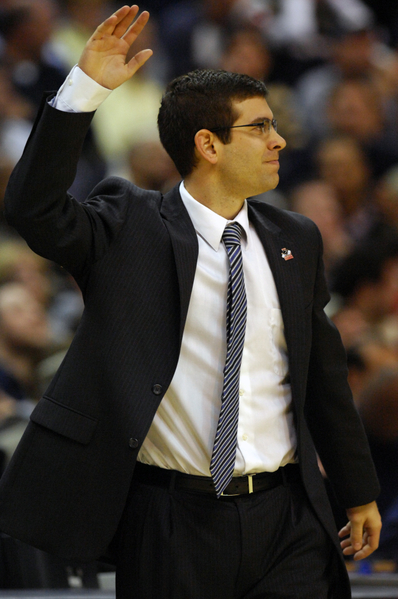When Talking About Size, It’s Money That Matters
Posted by jstevrtc on March 30th, 2011It’s obvious why everyone loves March Madness, but why do people particularly love it when schools like Butler and VCU make runs to the Sweet 16 and, in this year’s edition, the Final Four? For the same reason everyone loves the early-round upsets. It’s the perception of David beating Goliath, the idea that some unranked team from a little college nestled in the woods in middle America can knock off a squad long on hype and McDonald’s All-Americans from some Power Six conference team. Kentucky and Connecticut may have the majority of partisan fans in Houston this weekend, and we’re sure Butler and VCU will be represented as well as they can be, but any unaffiliated fans inside of Reliant Stadium and watching at home will be rooting for those little guys. One of the hottest topics we’ve heard on sports talk radio and read about in numerous outlets since the incredible wins by Butler and VCU over the weekend is how great it is that two small schools made the Final Four and that one of them is guaranteed to play for the national championship.
Wait…VCU? A “small” school? Maybe we need to redefine our terms.
(Dollar amounts from Basketball State, and are as of 2010.)
Check out that table. If you look at total enrollment, VCU is the biggest school in the Final Four. It’s the only school with more than 30,000 students, and of all the athletic revenues they brought in last year, they spend the second most money by percentage on men’s basketball of the four remaining teams. Butler, as you can see, spends the highest percentage of its athletic revenue on our game. So what exactly are people talking about when they use terms like “small school” and “little guy” to describe programs like VCU’s? What makes a school small in a basketball sense? How can the biggest school left in the Tournament be…a mid-major?
Obviously, the size of a school’s enrollment has little to do with any of this. When people talk of small versus large schools and their place in the college basketball hierarchy, what they’re talking about whether they know it or not is money. And that’s usually true dollars and cents, not percentages of money. It’s what Mid-Majority has been teaching for seven years, now. VCU spends 14.9% of its total athletc revenue on men’s basketball, but they don’t play football, so even though the men’s hoops team gets a nice share of what’s coming in, there isn’t that much coming in compared to everyone else. As you can see, Kentucky spends almost as much on men’s basketball as Butler — a I-AA (or whatever they call it now) football school with a fine tradition in that sport — makes from all sports. Butler men’s basketball gets over 20% of that money, and, with around 350 schools playing Division I basketball, you can see that both Butler’s and VCU’s expenses, while far less than Kentucky’s and even Connecticut’s, are still well within the top half of all D-I schools (the highest, by the way, is Duke, who spent about $700K more than UK in 2010). Is that “smallness?”
The answer will vary from person to person, because where you put that line is arbitrary. We tend to believe that there aren’t really “mid-major” schools, just schools that play in mid-major conferences, and a mid-major conference is any one that isn’t a so-called Power Six conference (Big East, SEC, ACC, Big Ten, Pac-10, Big 12). That term needs updating from year to year as conferences rise and fall in terms of their allocation of monies, perceived power and, er, bigness. Even with annual changes, that definition has its flaws (we don’t think that Dayton or Xavier, both A-10 schools, qualify as “small” or as mid-majors). And frankly, we don’t even like the term “mid-major.” The use of major implies that there’s a minor, and we don’t know of any schools or conferences calling themselves minors or mid-minors. But the point is that everyone has their own definition of what’s big or small, major or minor, and it’s usually an arbitrary one.
What really interests us the most, though, is where people assign morality based on their perception of size. Most people automatically go with a “big school = bad, small school = good” mentality, but if VCU has the highest enrollment and Kentucky the third smallest in the Final Four, should those people root for Kentucky harder than VCU? Or if you want to base it on pure income and expenses, does that mean Butler’s players deserve the championship more than the other three schools, having done more with less cash? What does that have to do with how hard players work and how much they care? And why should more money intrinsically be associated with evil, anyway?
We’ll have that discussion another time, but let us leave you with one final factoid. In terms of recruiting expenses, it doesn’t matter what definition of big or small that you use. Butler is the true little guy in this Final Four in that regard and qualifies one over the entirety of college basketball, as well. One of the stats we didn’t include in the chart above is the amount each school spends on recruiting. The entire men’s sports recruiting budget for Butler is $73,087. That’s for ALL men’s sports, meaning Brad Stevens and his staff get only a fraction of that. It ranks 282nd out of a possible 328 teams. Even VCU ranks 61 spots higher.











































